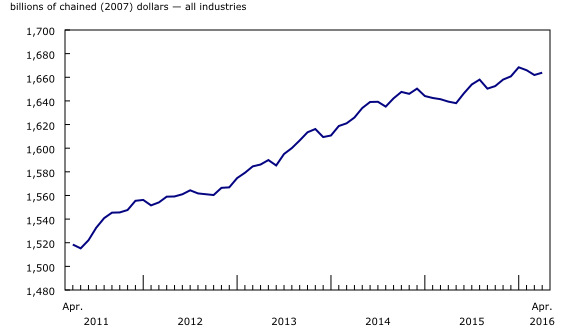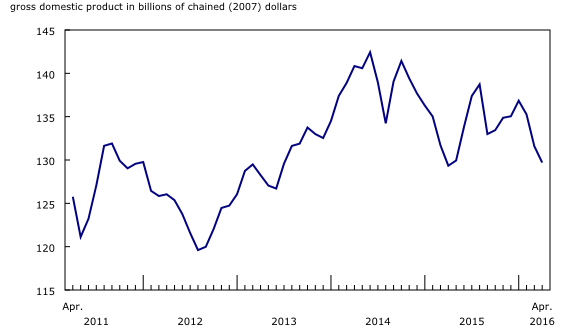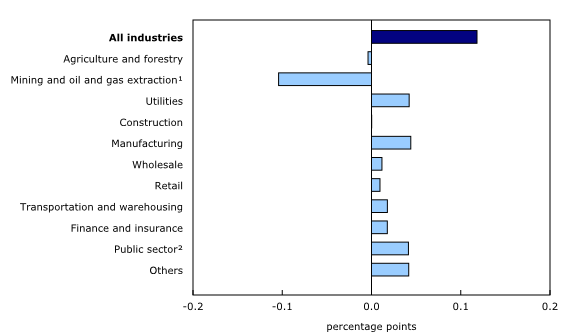Gross domestic product by industry, April 2016
Archived Content
Information identified as archived is provided for reference, research or recordkeeping purposes. It is not subject to the Government of Canada Web Standards and has not been altered or updated since it was archived. Please "contact us" to request a format other than those available.
Released: 2016-06-30
April 2016
0.1% 
(monthly change)
After decreasing in February and March, real gross domestic product edged up 0.1% in April. Widespread gains, notably in manufacturing, utilities and the public sector, were largely offset by a significant decline in non-conventional oil extraction.
Service-producing industries rose 0.2% in April, after being essentially unchanged in March. Notable gains were posted by the public sector (education, health and public administration combined), the finance and insurance sector, and wholesale and retail trade. In contrast, the arts, entertainment and recreation sector notably declined.
The output of goods-producing industries edged down 0.1% in April, mainly as a result of a decrease in mining, quarrying, and oil and gas extraction. Manufacturing and utilities posted notable increases, while the agriculture and forestry sector was down.
Mining, quarrying, and oil and gas extraction falls again
Mining, quarrying, and oil and gas extraction fell for a third consecutive month in April, declining 1.4%.
The main reason for the drop in this sector in April was a 2.4% decline in oil and gas extraction, as output from non-conventional oil extraction (-7.3%) was lower, mainly as a result of maintenance shutdowns at upgrader facilities. These declines preceded the wildfires in the Fort McMurray and Wood Buffalo region of northern Alberta that occurred in May, a significant event for the non-conventional oil extraction industry. Conventional oil and gas extraction increased 1.7% in April.
Support activities for mining and oil and gas extraction were down 2.1% in April, a third consecutive monthly decrease. Output of support activities for mining and oil and gas extraction remained at low levels similar to those seen in early 2015.
Mining and quarrying (excluding oil and gas extraction) grew 1.5% in April. A 7.1% rise in metal ore mining in April more than offset the 4.8% decline in March, as iron ore mining returned to normal levels of activity in April. Non-metallic mineral mining decreased for a third month in a row, mainly as a result of lower output from potash mining. Coal mining fell in April, offsetting the gain in March.
Manufacturing output rises
After two consecutive monthly decreases, manufacturing output rose 0.4% in April.
The rise in manufacturing output in April was attributable to non-durable goods manufacturing (+0.9%), up for the third consecutive month. Manufacturing of petroleum and coal products, chemicals and, to a lesser extent, beverage and tobacco products was up. Conversely, a notable decline was posted by plastic and rubber products manufacturing.
After decreasing for two consecutive months, durable-goods manufacturing was unchanged in April. Gains were notable in transportation equipment manufacturing, primary metal manufacturing and, to a lesser extent, miscellaneous manufacturing. On the other hand, machinery manufacturing and wood product manufacturing posted notable declines.
Utilities increase
Utilities increased 1.9% in April. The electric power generation, transmission and distribution industry and the natural gas distribution industry were both up, as much of central Canada experienced colder than usual weather in April.
The public sector increases
The public sector (education, health and public administration combined) rose 0.2% in April, primarily due to growth in public administration. Educational services increased, while health care services were unchanged.
Wholesale and retail trade increase
Wholesale trade increased 0.2% in April. Output grew for miscellaneous wholesalers (including wholesalers of agricultural chemicals), petroleum product wholesalers and, to a lesser extent, food, beverage and tobacco wholesalers. The output of wholesalers of machinery, equipment and supplies, building material and supplies, and motor vehicles and parts decreased.
Retail trade rose 0.2% in April, mainly as a result of higher output at furniture and home furnishings stores, general merchandise stores (which include department stores), and miscellaneous store retailers. In contrast, activities at clothing and clothing accessories stores were notably down.
Construction unchanged
Construction was unchanged in April. An increase in engineering construction was offset by a decrease in residential building construction, which declined in April after four consecutive gains. Repair construction was down, while non-residential building construction was unchanged.
The output of real estate agents and brokers increased for the seventh consecutive month, up 3.3% in April. Home resale activity was higher across most markets in Canada.
The finance and insurance sector grows again
After rising 0.4% in March, the finance and insurance sector grew 0.3% in April, as a result of higher output from financial investment services. Banking services were unchanged, while insurance services edged down.
Other industries
Transportation and warehousing services grew 0.4% in April. Pipeline transportation of natural gas rose, as demand from the northeastern United States increased, due to below-average seasonal temperatures. Output from trucking and postal services advanced, while rail transportation declined to its lowest level since November 2014.
The arts, entertainment and recreation sector declined 3.9%, mainly as a result of a drop in spectator sports and related industries, as there were no National Hockey League playoff games played in Canada in April.
Note to readers
Monthly gross domestic product (GDP) by industry data at basic prices are chained volume estimates with 2007 as the reference year. This means that data for each industry and each aggregate are obtained from a chained volume index, multiplied by the industry's value added in 2007. Monthly data are benchmarked to annually chained Fisher volume indexes of GDP obtained from the constant-price supply and use tables (SUT) up to the latest SUT year (2012).
For the period starting with January 2013, data are derived by chaining a fixed-weight Laspeyres volume index to the prior period. The fixed weights are 2012 industry prices.
This approach makes the monthly GDP by industry data more comparable with expenditure-based GDP data, which are chained quarterly.
All data in this release are seasonally adjusted. For information on seasonal adjustment, see Seasonally adjusted data – Frequently asked questions.
For more information on GDP, see the video, "What is Gross Domestic Product (GDP)?"
Revisions
With this release of monthly GDP by industry data, revisions have been made back to January 2015.
Each month, newly available administrative and survey data from various industries in the economy are integrated and result in statistical revisions. Updated and revised administrative data (including taxation statistics), new information provided by respondents to industry surveys, and standard changes to seasonal adjustment calculations are incorporated with each release.
For more information about monthly national GDP by industry, see the System of Macroeconomic Accounts module on our website.
Real-time CANSIM tables
Real-time CANSIM table 379-8031 will be updated on July 20. For more information, consult the document, Real-time CANSIM tables.
Next release
Data on GDP by industry for May will be released on July 29.
Contact information
For more information, contact us (toll-free 1-800-263-1136; 514-283-8300; STATCAN.infostats-infostats.STATCAN@canada.ca).
To enquire about the concepts, methods or data quality of this release, contact Allan Tomas (613-790-6570), Industry Accounts Division.
- Date modified:




